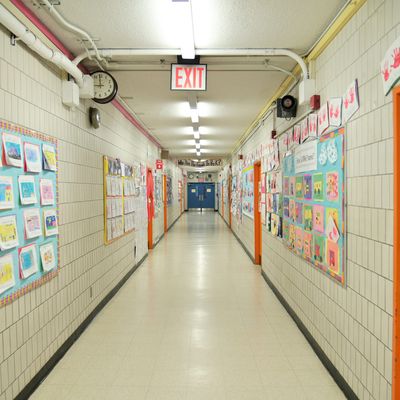
Andrew Worthington’s public school was in trouble even before the coronavirus struck. “We have lead in the pipes,” the Manhattan-based English teacher said. “We have all sorts of rodents. There’s soot in the ventilation system. The bathrooms are constantly out of service.” When school is in session, Worthington said, most classes have over 30 students. About 80 percent of the student body qualifies for free and reduced lunch, and many lack the tech they now need to keep up with classes.
After the pandemic turned classrooms dangerous, Worthington’s students faced widening gaps. The iPads the school handed out could only do so much. “It’s hard for them to write essays on a tablet,” Worthington observed.
Like any natural disaster, the pandemic is a stress test for our systems and institutions. It locates their weak spots, and presses until something snaps. Public education could be its next casualty, advocates and experts told Intelligencer; a victim not just of the virus, but of something older and more deliberate, too. America’s public schools haven’t been properly funded for years. Twenty-nine states spent less on public education in 2015 than they did in 2009, the Center on Budget and Policy Priorities has reported. Local governments in 19 states cut per-pupil spending over the same time period; elsewhere, small increases couldn’t make up for drastic, state-level reductions. If schools buckle now under the weight of the pandemic, lawmakers bear much of the blame.
With school back in session, administrators and teachers alike must stretch already scarce resources to meet new demands. If school buildings reopen at all, social-distancing demands smaller class sizes and more teachers. If schools keep classes virtual, poor students need tools that their districts might not be able to afford. Because the pandemic helped spawn a recession, schools also face crippling cuts as state and local tax revenue contracts. A new report from the American Federation of Teachers projects a funding gap of $93.5 billion for pre-K–12 education, and an additional $45 billion gap for higher education. Unless Congress and Donald Trump can agree on a rescue package, the union estimates that around one million jobs for pre-K–12 educators will disappear.
Maybe no one could have prevented coronavirus, or something equally drastic, from transforming public life and public schools. But the situation didn’t have to be quite so dire, said Diane Ravitch, an education historian and the founder of the Network for Public Education. “We have been through a long period of devaluing public education, especially the education of children who are poor,” she told Intelligencer by email. “High-wealth communities invest in their schools. In poor neighborhoods, where children have low test scores, politicians have opened charter schools and offered vouchers, which saps funding from schools that need it most.”
Lily Eskelsen Garcia, the president of the National Education Association, put matters in even blunter terms. “I hear the word ‘chronic,’ and that’s a good word,” she said. “But there’s another word that has to be put with it, and that’s ‘intentional.’” Lawmakers, she added, “are intentionally, chronically underfunding our schools.”
As the president of the nation’s largest teachers’ union, Eskelsen Garcia’s position makes sense. It’s her job to secure the best deal possible for her 3 million-member base. But the facts are also in her corner. Consider Andrew Worthington’s school in Manhattan: The state of New York owes it some money. Almost $600,000, to be exact. That’s a healthy chunk of its annual budget, which is just over $5.2 million for the upcoming fiscal year. The debt is the legacy of an old court case, and an older inequity. The New York State Court of Appeals ruled in 2006 that the state had failed to uphold one of its fundamental constitutional obligations: to provide all students a “sound, basic education.” Albany had underfunded New York City schools for years, parents argued, which deprived kids of the resources enjoyed by other districts. After the state lost the case, lawmakers devised a funding formula, called Foundation Aid, to repay public schools what they owed. But as City & State reported last year, the last major recession forced the state to slash spending, and activists and teachers insist that Foundation Aid never fully recovered. One report from the Alliance for Quality Education suggests the state owes schools $4 billion, a figure that Governor Andrew Cuomo disputes.
But New York’s just one example of a much broader phenomenon. Public school funding in the U.S. depends on a hodgepodge of property taxes plus the financial whims of local and state governments and, to a lesser extent, some additional federal money. On a district by district basis, the officials who draw attendance zones can reproduce inequality for successive generations of children. Schools that are geographically close to one another can also be worlds apart. At Walt Whitman High School in wealthy Bethesda, Maryland, kids can study Japanese or ceramics or biotechnology and bioengineering. A mere two percent of the student body receives free or reduced lunch, according to data collected by ProPublica in 2018. But Montgomery County isn’t universally well-off. The school system is highly segregated. Whitman is mostly white: The astonishing resources it has to offer aren’t available to lower-income, majority non-white communities in the county.
The recession of 2008 made a bad situation worse. States decimated education budgets, in part because they didn’t get enough federal aid, explained Michael Leachman of the Center on Budget and Policy Priorities. Local funding didn’t make up the resulting disparity. “They had to balance their budgets, and they had to either cut spending or raise taxes,” he said. Most cut spending until the economy began to improve. New York, for example, did increase its contributions to Foundation Aid in the years after the recession; it just doesn’t fully fund the program. The pandemic crisis that public schools face looks preventable, even predictable, in hindsight. In 2008, the events of the recession warned of trouble to come. Cuts that some lawmakers viewed as an unfortunate and temporary setback looked more like an opportunity to others. As Arizona wicked funding away from traditional public schools, Republicans encouraged the growth of privately-run charter schools. So did Florida – and so, for that matter, did New York, which isn’t exactly a Republican stronghold. That matters, said Ravitch. “Charters and school vouchers have diverted funding from public schools, setting them up for failure today,” she explained. Teachers’ unions agree, and so does some research.
Once again, New York is hardly the nation’s worst offender. According to Leachman’s co-authored research for the CBPP, the state of Arizona cut funding for public education by over a third from 2009 to 2015. A statewide teacher walkout in 2018 nudged funding levels up by a significant degree, but overall, the state education budget still lags far behind the 2008 standard. Florida, in second place, cut funding by 22 percent. Both states now lead the nation by another metric: By mid-July, Florida ranked second only to California for positive cases of COVID-19. Arizona led the world in per-capita COVID-19 infections for a time in June. When those states reopen schools next month, they’ll have to accommodate a raging pandemic with recession-era funding, all while new budget cuts loom in the middle distance.
The picture doesn’t look much better at the national level. “When the pandemic hit, states nationally had seventy-seven thousand fewer teachers and other school workers than they did when the Great Recession really took hold, even though they’re trying to teach about a million and a half more kids,” Leachman added.
In essence, public schools face a triple shock. A new and more radical recession befell them before their funding had even recovered from the last one. The pandemic, meanwhile, creates new expenses and new demands for them to meet. It’s a catastrophic scenario, and Congress has yet to formalize a solution. Both major parties realize that public schools need aid, Politico reported on Tuesday, but they’re at odds on the details. Republicans may want to condition any assistance on a guarantee that public schools will reopen normally next month, as preferred by President Trump. Teachers’ unions, including the NEA, believe that’s premature, as do most Americans overall. Just one out of every ten people supports a normal reopening in August, a new AP/NORC poll reported on Wednesday. In lieu of a reasonable solution, public education remains what it has been for years: a pawn in a political game.
A decade after the recession, teachers raised the red flag again. They walked out of schools in droves and launched protests that continued well into 2019. The demands of the Red for Ed movement varied slightly from state to state, but the core complaint was always the same. The stagnant wages, the crumbling buildings, and the lack of school nurses and counselors all stemmed from one problem: Traditional public schools didn’t have enough money, and lawmakers deserved the blame. At the CBPP, Leachman and his colleagues determined that the walkouts did lead to increases in school funding, but temporary reprieves couldn’t prepare public schools for a national disaster or make up for decades of neglect.
The real problem, said Eskelsen Garcia, is old. Older than the new recession or the last recession or even the invention of charter schools. “It started with Brown v. Board of Education,” she said. Opponents of desegregation found other ways to keep schools separate and unequal. It’s not an accident, she added, “that the poorer communities do not have what the richer communities have.” If academic discrepancies distinguish majority-white schools from non-white schools in Montgomery County, it isn’t because teenagers in Bethesda are any more gifted than students who live somewhere else. They exist because of political decisions, and they could be rectified by political decisions, too.
But Worthington, who belongs to the Movement of Rank and File Educators caucus of the United Federation of Teachers, doesn’t sound optimistic that legislators will act. Even with the recession in force, Democrats could be doing more than they are, he said. “I’m confused about their revenue-generation priorities,” he added. “It doesn’t seem like they’re going to be increasing taxes on the ultrawealthy enough. Legalizing recreational marijuana would be another source of revenue, and they’re not doing that, either.” At the city level, he continued, Mayor Bill de Blasio and members of the City Council ignored activists’ calls to defund the police and redistribute the goods elsewhere, perhaps to schools.
At the state level and in Congress, whatever lawmakers do next will reverberate for years. There’s more than an academic year at stake. Another crisis will come next year or a decade from now, and public schools will have to meet it. Wealthy students can flee to private schools or tutoring “pods” with their peers, but students in poverty will have no choice but to walk through the doors of the nearest free school. “We don’t want to go back to what we had before,” said Eskelsen Garcia. “What we had was not fair.”






























